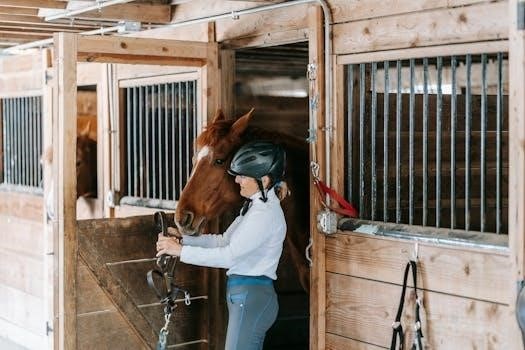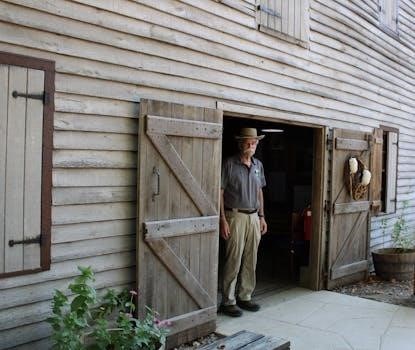
Barn Door Installation⁚ A Comprehensive Guide
This comprehensive guide will walk you through the process of installing a barn door, from initial preparation to final adjustments. We’ll cover key steps, safety considerations, and troubleshooting tips, ensuring a smooth and successful DIY project. Whether you’re a seasoned pro or a first-time installer, this guide will help you get the job done right.
Preparation and Planning
Before commencing any installation, thorough preparation is paramount. Begin by carefully measuring the doorway opening, noting both height and width, ensuring the barn door will adequately cover the space with a slight overlap. Assess the wall’s structural integrity, locating studs to guarantee secure mounting of the track, which is crucial due to the door’s weight. If the wall is not plumb, consider using a header board for a level surface. Gather all necessary tools including a level, drill, measuring tape, pencil, and safety goggles. Unpack all components, ensuring all required hardware is present, and familiarize yourself with the installation manual. Acclimate the door to the room’s environment to avoid any warping. If using a kit, review provided instructions, and if not, acquire suitable hardware. Clear the installation area of any obstructions, ensuring a safe and efficient work environment. It is highly recommended to have a helper for certain steps, especially lifting the door. Double-check measurements and ensure you understand all steps before starting. Protect your eyes using safety goggles throughout the process.
Measuring and Marking
Accurate measurements and precise markings are vital for a successful barn door installation; Start by measuring the width of the doorway, adding at least one inch on each side to ensure full coverage and privacy. Next, determine the desired height, typically allowing for a small gap at the bottom. Use a level to establish a horizontal line where the track will be installed, accounting for the door’s height and the floor clearance. Mark the stud locations above the doorway, as these will be the secure points for the track. Double-check all measurements, especially if the floor is uneven, measuring at both open and closed positions. Once the track location is determined, use a pencil to clearly mark all the drilling points. If installing floor guides, carefully measure and mark their position, aligning them with the door’s travel path. It is crucial to be precise during this stage, as any errors can lead to operational issues. Always verify your measurements before drilling any holes. Proper marking ensures the door slides smoothly and securely.

Hardware Installation⁚ Track and Hangers
The hardware installation, focusing on the track and hangers, is a critical step for proper barn door functionality. Begin by aligning the pre-drilled track with the marked stud locations above the door opening. Use a level to ensure the track is perfectly horizontal; Secure the track to the wall using appropriate screws and anchors, paying close attention to the weight capacity of the hardware. If installing on a concrete wall, use concrete anchors provided in the kit. Once the track is securely mounted, it’s time to attach the hangers. These often come with wheels that will glide along the track. Attach the hangers to the door according to the manufacturer’s instructions using carriage bolts. Ensure that the hangers are properly aligned and that the bolts are tightened securely. It’s essential to double-check all hardware connections before proceeding. Incorrect installation of track and hangers may cause the door to not function properly or become unsafe.
Door Attachment to Track
Attaching the door to the track requires careful lifting and alignment. With assistance, lift the barn door and carefully position the hanger wheels onto the track. Ensure that the wheels sit securely within the track grooves. Gently slide the door along the track to test its movement and ensure that the hangers are properly engaged. Check that the door slides smoothly and without any obstruction. If using anti-jump blocks, rotate them towards the back of the door once it’s on the track. This will prevent the door from jumping off the track. It’s vital to make sure all connections are secure and the door is hanging correctly before proceeding. Double-check that the door moves freely from end to end of the track, and that the weight is evenly distributed. Any signs of instability or uneven weight distribution should be addressed immediately. This step is critical for safe and smooth operation of the barn door.

Floor Guide Installation
The installation of the floor guide is essential for maintaining the stability and proper movement of the barn door. First, position the door where it will be when fully open and measure from the inside edge of the door to the wall. Mark this point on the floor. This mark will serve as a reference for the floor guide placement. Align the chosen floor guide, often a T or J-shaped guide, with this marked line, ensuring it is parallel to the door’s path. If your floor is concrete you may need to pre-drill holes using the guides screw locations as a guide and insert anchors before securing the guide with the screws provided. Plumb the door and use blocks to keep it square to the floor, this is important before installing the guides. Make sure the guide is not interfering with the door’s movement and it is spaced so the door hangs correctly. Once the guide is correctly positioned, securely fasten it to the floor using the appropriate screws and anchors, ensuring that it is firm and stable. Recheck that the door slides smoothly within the floor guide.
Door Stops and Soft Close Mechanism
Installing door stops and a soft close mechanism enhances both the functionality and safety of your barn door system. Begin by positioning the door in its fully closed position. Then, carefully slide the door along the track, noting where it should stop to prevent it from hitting the wall or door frame. Mark these locations on the track. The door stops are then installed at these marked positions on the track, typically using screws or set screws. These stops prevent the door from moving beyond its intended travel range. If you are installing a soft close mechanism, the process will vary slightly depending on the specific hardware you’re using. However, in general, the soft close mechanism is designed to smoothly slow the door’s movement before it reaches the door stop position, preventing slamming. It typically involves attaching a specialized component to the track and the door. Follow the manufacturer’s instructions to install it correctly. Once all is in place, test the system to make sure the door stops at the correct points and the soft close mechanism functions properly.
Adjusting and Testing the Door

Once the barn door is installed, the crucial step of adjusting and testing begins. This phase ensures smooth and safe operation. Start by sliding the door along the entire length of the track, paying close attention to any resistance or unusual sounds. If the door seems to be sticking, double-check the alignment of the track, hangers, and the floor guide. Slight adjustments to these components might be needed. Ensure the door is gliding freely without any friction. Next, verify that the door stops are positioned correctly, preventing the door from slamming into the wall or the door frame at both open and closed positions. If a soft-close mechanism is installed, confirm that it engages properly, slowing the door before it reaches the stops. Make minor adjustments to the soft close hardware as necessary, following the manufacturer’s guidelines. After all adjustments, continue to test by sliding the door back and forth several times to guarantee consistent performance. This thorough testing step will catch any minor issues early and prevent problems in the future.
Addressing Uneven Floors and Walls
Uneven floors and walls present challenges when installing barn doors, but these can be effectively addressed with careful planning. If your floor is not level, the door might not glide smoothly, and the floor guide could bind. To correct this, use shims under the floor guide to level it properly. Measure the floor’s height at both ends of the door’s travel path, and adjust the guide accordingly. For walls that are not plumb, a header board or backer board will compensate. Secure the board to the wall, making sure the board is level before mounting the track. This ensures the door hangs straight and operates smoothly. It might be necessary to add shims behind the header board if the wall is significantly uneven. It’s important to use a level to check the plumb of the wall and the levelness of the floor before starting the installation and make adjustments as necessary. Ignoring these irregularities can affect the door’s functionality and appearance.
Safety Considerations
Prioritizing safety is crucial during barn door installation. Always wear safety goggles to protect your eyes from debris and dust. Keep the installation area clear of clutter to prevent trips and falls. Due to the weight of barn doors and hardware, it is recommended to have at least two people assist with lifting and mounting. Be mindful of the heavy components and avoid overexertion. Ensure the hardware is correctly assembled and securely mounted, as improper installation can cause the door to detach or malfunction, posing a risk of injury. When drilling into walls, be aware of the location of electrical wiring and plumbing to prevent accidents. If working with power tools, follow the manufacturer’s instructions and safety recommendations. Double-check all screws and bolts to ensure they are tightened to the correct torque. Finally, thoroughly test the door’s operation after installation to verify its stability and safety before allowing normal use. By taking these precautions, you can ensure a safe installation.
Troubleshooting Common Issues
Encountering issues during barn door installation is not uncommon. If the door is not sliding smoothly, check that the track is level and free from obstructions. Make sure the rollers are properly aligned and lubricated. If the door is rubbing against the wall, adjust the door stops or track position. A common problem is the door not hanging plumb; this often requires adjusting the hangers or shimming the track. If the floor guide is not correctly aligned, it can cause the door to bind; ensure the guide is centered and correctly positioned. If you find screws are loosening, tighten them further, or use a thread-locking adhesive. If the soft-close mechanism isn’t working, verify that all components are installed and aligned correctly and according to the manufacturer’s instructions. If you have issues with doors not closing completely, check the door stops and track for proper placement. When in doubt, consult the manufacturer’s instructions or seek professional assistance to address complex issues. Addressing issues promptly prevents more significant problems later.
Maintenance and Care
Maintaining your barn door ensures its smooth operation and longevity. Regularly inspect the track for debris, dust, or obstructions and clean it with a dry cloth. Periodically lubricate the rollers and hinges with a silicone-based lubricant to reduce friction and prevent squeaking. Check all screws and fasteners to make sure they are tight and secure. If you notice any loose or wobbly components, tighten them immediately. Clean the door surface with a mild soap and water solution, avoiding harsh chemicals that could damage the finish. For wooden doors, apply a wood polish or conditioner to preserve the wood and prevent drying or cracking. If your door has a soft-close mechanism, check its functionality regularly and ensure no components are damaged. If the soft-close fails, replace it immediately. If any part becomes damaged or broken, replace them immediately. Protect the door from moisture or prolonged exposure to sunlight, as this can lead to warping or fading. Consistent maintenance keeps your barn door looking and functioning its best for years to come.
